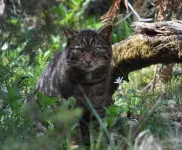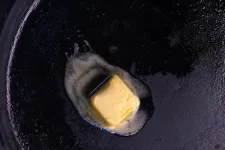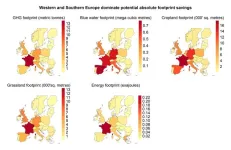European wildcats avoided introduced domestic cats for 2,000 years
Domestic cats introduced from the Near East, and wildcats native to Europe did not mix until the 1960s, despite being exposed to each other for 2,000 years
2023-11-06
(Press-News.org) University of Oxford news release
Strict embargo until Monday, 6 November, 2023. 11.00 (ET) or 16.00 (GMT)
Domestic cats introduced from the Near East and wildcats native to Europe did not mix until the 1960s, despite being exposed to each other for 2,000 years, according to two research papers published today in Current Biology.
An international team has found new archaeological and genetic evidence which transforms our understanding of the history of cats in Europe. The team sequenced and analysed both wild and domestic cats, including 48 modern individuals and 258 ancient samples excavated from 85 archaeological sites over the last 8,500 years. They then assessed the patterns of hybridisation after domestic cats were introduced to Europe over 2,000 years ago and came into contact with native European wildcats.
The results of the studies demonstrate that, since their introduction, domestic cats and European wildcats generally avoided mating. About 50 years ago in Scotland, however, that all changed. Perhaps as a result of dwindling wildcat populations and a lack of opportunity to mate with other wildcats, rates of interbreeding between wild and domestic cats rose rapidly.
Jo Howard-McCombe from the University of Bristol and the Royal Zoological Society of Scotland explains, ‘Wildcats and domestic cats have only hybridised very recently. It is clear that hybridisation is a result of modern threats common to many of our native species. Habitat loss and persecution have pushed wildcats to the brink of extinction in Britain. It is fascinating that we can use genetic data to look back at their population history, and use what we have learnt to protect Scottish Wildcats.’
Professor Greger Larson, from the University of Oxford, says, ‘We tend to think of cats and dogs as very different. Our data suggests that, at least with respect to avoiding interbreeding with their wild counterparts, dogs and cats are much more similar to each other than they are to all other domestic animals. Understanding why this is true will be fun to explore.’
Professor Mark Beaumont, from the University of Bristol, adds, ‘The nature of the Scottish wildcat and its relation to feral domestic cats has long been a mystery. Modern molecular methods and mathematical modelling have helped to provide an understanding of what the Scottish wildcat truly is, and the threats that have led to its decline.”’
Domestic animals including cattle, sheep, goats, dogs, and pigs have been closely associated with people since the emergence of farming communities more than 10,000 years ago. These tight relationships led to the human-mediated dispersal of plants and animals well beyond their native ranges.
Over the last decade, genomic sequences of modern and ancient individuals have revealed that, as domestic animals moved into new regions, they interbred with closely related wild species, which has dramatically altered their genomes. This pattern has been seen in every domestic animal, except dogs. It would be fascinating to know whether domestic cats interbred with European wildcats, but the decline of native wildcat populations across Europe, and the lack of ancient cat genomes has made it difficult to do so.
The two studies, were carried out at universities in Munich, Bristol, Oxford and the Royal Zoological Society of Scotland.
END
[Attachments] See images for this press release:

ELSE PRESS RELEASES FROM THIS DATE:
2023-11-06
This huge step forward in understanding how neurons communicate through extremely short proteins called neuropeptides will help scientists understand how our emotions and mental states are controlled, as well as widespread neuropsychiatric conditions like eating disorders, OCD and PSTD.
The map, which details 31,479 neuropeptide interactions between the worm’s 302 neurons, shows where each neuropeptide, as well as each receptor for those peptides, acts in the animal’s nervous system. Neuropeptides allow communication between neurons that are not immediately ...
2023-11-06
Reykjavik 6. November 2023.
Epidemiology and Genetics of Clonal Hematopoiesis, a Premalignant Hematopoietic Stem Cell Condition
A comprehensive new study from deCODE genetics, a subsidiary of Amgen, published today in Nature Genetics, provides insights into the epidemiology and somatic and germline genetics of clonal hematopoiesis. Whole genome sequence data from Iceland and the UK Biobank, combined with a unique somatic mutation Barcoding strategy, was used to investigate clonal hematopoiesis at the population scale.
Clonal hematopoiesis is a condition that arises when a single clonal lineage ...
2023-11-06
About The Study: In this study of 185 women with breast cancer, high neighborhood deprivation was associated with differences in tissue DNA methylation and gene expression among Black women. These findings suggest that continued investment in public health interventions and policy changes at the neighborhood level may help to remedy biological alterations that could make minoritized populations more susceptible to chronic diseases.
Authors: Stefan Ambs, Ph.D., of the National Cancer Institute in Bethesda, ...
2023-11-06
Irvine, Calif., Nov. 6, 2023 — Agriculture is one of the hardest human activities to decarbonize; people must eat, but the land-use practices associated with growing crops account for roughly a quarter of global greenhouse gas emissions. Researchers at the University of California, Irvine and other institutions evaluate a new solution to this problem, one that eliminates farms altogether.
In a study published today in Nature Sustainability, the UCI-led team of scientists assess the potential for widescale synthetic production of dietary fats through chemical and biological processes. The raw materials for this method are the same as those used by ...
2023-11-06
Keeping an eye on the regions when it comes to climate change
Up to now, the results of climate simulations have sometimes contradicted the analysis of climate traces from the past. A team led by the physicist Thomas Laepple from the Alfred Wegener Institute in Potsdam and the climatologist Kira Rehfeld from the University of Tübingen has therefore brought together experts in climate models and climate tracks to clarify how the discrepancies come about. The surprising result has now been published in the journal Nature Geoscience: in a way, both sides ...
2023-11-06
BOSTON – In June 2022, the U.S. Supreme Court overruled Roe v. Wade, effectively ending 50 years of federal protections to abortion care. As of October 2023, twenty-six states have since enacted laws to ban or restrict abortion access, with 14 states completely banning the procedure. Today, an estimated 25 million American women of childbearing age, or about one third of women ages 15 to 45, live in areas where abortion care is severely restricted. Historically, many states were able to restrict access to abortion even before 2022 through Targeted Regulation of Abortion Providers (TRAP) laws; these laws decrease ...
2023-11-06
Multiple sclerosis patients whose blood tests reveal elevated NfL, a biomarker of nerve damage, could see worsening disability one to two years later, according to a new study spearheaded by researchers at UC San Francisco.
The study is the first to quantify the timeframe preceding disability worsening in which injury to the central nervous system takes place, said co-first author Ahmed Abdelhak, MD, of the UCSF Department of Neurology and the Weill Institute for Neurosciences.
Almost 1 million Americans ...
2023-11-06
Article in Nature Communications demonstrates that with 96% sensitivity, AI diagnostic MSIntuit™ CRC can rule out almost half of the MSS population of colorectal cancer patients unlikely to respond to checkpoint inhibitor therapy from additional screening.
Such AI-enabled solutions have the potential to improve lab efficiency, addressing global pathology shortages and reducing testing burden to match the right patients to the right therapies.
Paris and New York., 6 Nov 2023 – In a peer-reviewed study published today in Nature Communications, a team of scientists ...
2023-11-06
New research shows that European food consumption draws unnecessarily excessively on global resources, which is why researchers are calling for political action. Many of the foods that are consumed in Europe are produced in countries outside Europe. Food loss – and waste later in the chain, (read more on waste terms below) – occurs along the food supply chain, from the primary agricultural sector in Europe or rest of the world, until it feeds mouths in Europe.
“Halving Europe’s food loss and waste, together with a redistribution of global food resources, could solve the challenges of food shortages in the ...
2023-11-06
A new virtual brain bank spanning five Chicago academic medical centers and led by University of Illinois Chicago will create a powerful new resource for clinical care and research on epilepsy, brain tumors and neurological disorders.
A $5 million grant from the National Institutes of Health will create a network of brain tissue research at UIC, Northwestern University, Lurie Children’s Hospital, Rush University and University of Chicago. The institutions will utilize a data platform developed at UIC called INTUITION that combines tissue data with clinical, functional, genetic and 3D imaging information to assist clinicians treating patients and help researchers better understand ...
LAST 30 PRESS RELEASES:
[Press-News.org] European wildcats avoided introduced domestic cats for 2,000 years
Domestic cats introduced from the Near East, and wildcats native to Europe did not mix until the 1960s, despite being exposed to each other for 2,000 years





